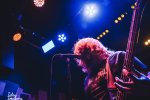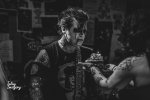Blerta
Bio

Blerta, short for the Bruno Lawrence Electric Revelation and Traveling Apparition, was formed in October 1971. The concept was to have a traveling band of musicians, actors, light show operators, movie people and friends on a relaxing holiday-type tour of New Zealand, to get away from the high pressure show business scene.
Bruno put together a group of people which included Corben Simpson, Alan Moon and Tony Littlejohn, all from Bruno's previous involvement with Littlejohn. Alan Moon had originally played with Sons and Lovers and Bruno lured another ex-Sons and Lovers player, Kemp Turirangi. Bruno acquired the bus that Kemp and Alan had previously used for tours. Also added to the group was Chris Seresin, the young keyboard player who had impressed Bruno during his stint in Fresh Air. Geoff Murphy, and his family, a friend Bruno had made from his very early days also joined. Bruno wanted a woman vocalist as well and invited Beverley Morrison along. Beverley soon became known by her nickname "Beaver". A late addition was Eric Foley, to play saxophone.
The group was now ready and on 30 October 1971 Blerta left Wellington on the first of two pre-tour trips to the Wairarapa. They played to small audiences, but found if they sent an advance party to put up posters and generally create an interest, more people were attracted. The trip was not a financial success, but showed that it was possible to continue with the concept.
On 22 November, the Blerta entourage boarded the inter-island ferry to take them on a tour of the South Island. Changes involved Eric Foley leaving and Don Burke being added on guitar. Bill Stalker from Pukemanu and Bill Gruar from Tank Busters were added to increase the acting potential. Added in were more wives, girlfriends and roadies. There were four other vehicles as well as the bus that made the trip. They didn't get very far before Corben found that there were drugs on the bus and he was having no part of it. He quit on the spot and made his own way back to Wellington.
They first played to a small audience in Blenheim and then moved on to Christchurch. There they did some extensive promotions, which paid off when an audience of over five hundred turned up to see an extraordinary show which left them knowing they had certainly experienced something, but were unclear as to exactly what that had been.
From there it was on to Timaru, and they were pleasantly surprised when Corben showed up during their performance. The troupe were happy to have him back. Shows at Dunedin and Alexandria were more polished and well attended, and by the time the group arrived at Queenstown, public awareness was growing. After a struggle for acceptance with the locals, the troupe finally won their hearts after performing free shows for the kids. The dances were well supported and Blerta were even invited to play in Queenstown on new years eve, a time when the population of the town traditionally swells. This event resulted in an astounding success.
From Queenstown, the troupe worked its way back up the west coast, playing at each town, in order to earn enough to feed them and get them to the next town. They finally made it back to Wellington in February 1972.
Whilst back in Wellington, Blerta had their first recording session at HMV studios. From this session came the single 'Dance Around The World'. Geoff Murphy wrote the lyrics and Corben Simpson put them to music while they were on their South Island tour. Corben sings the lead and Bill Stalker does the voice-over part. The flip-side, 'Freedom St Mary's', was written by Chris Seresin and Bruno.
Tony Littlejohn left the troupe at this point. They were about to head off again up the North Island. Don Burke also decided to stay behind and Kemp indicated he would be leaving shortly. The bus made it all the way to Kaitaia, the band receiving mixed receptions along the way. News reached them that 'Dance Around The World' was a recording success, so they headed straight back to Wellington.
In May 1972 'Dance Around The World' peaked at #13 on the National Charts. With its success HMV naturally wanted a follow-up single, but Blerta were without available musicians or a suitable original composition. A lead guitarist was needed, so Bruno organised Chaz Burke-Kennedy, who Bruno had played with in Fresh Air. The composition they chose was a song Bruno and Corben put together called 'Aunty Ada'.
It was one of the weirdest singles ever released by a major New Zealand company. The flip-side was written and sung by Bruno and called 'Everybody Has Their Way'. This song had previously been recorded by Quincy Conserve while Bruno had been with them. When the single was released in July, it disappeared without a trace. A third single released in November 1972 suffered a similar fate. It was a Geoff Murphy composition called 'Hullo Hullo' with Bruno on lead vocals. It was backed with 'Blerta Jam and Pudding'. Again the single was ignored by radio and failed to sell.
In November 1972, EMI promoted a concert at the James Hay Theatre in Christchurch. Blerta performed there along with Lutha, Quincy Conserve and Desna Sisarich. The event was recorded and released early in 1973 as an album called 'Live'. Blerta contributed three tracks to the album.
Before departing on the next tour, Bruno recruited some new musicians and actors to bolster the ranks. Bruno and Chris Seresin were the only surviving full-time musicians from the original Blerta. Corben's involvement was now only part-time as he had his own solo career to deal with. Chaz Burke-Kennedy took on the role of lead guitar. George Barris, who was also from Fresh Air, would join the tour on bass, but until he arrived, Billy Williams filled in. Dick Wyeth also joined on saxophone. Bill Stalker was still with them and three new actors were added. They were Ian Watkin, Grant McFarland and Tony Barry. Two other new musicians joined, Greg Taylor on saxophone and Mike Flaws, who would become known as Fane Flaws, on guitar.
In November 1972 Blerta made the finals of the Loxene Golden Disc Awards with 'Dance Around The World' and in January 1973 they appeared at New Zealand's first large scale festival at Ngaruawahia. While at the festival, Bruno met Trevor Stone from Australia, who was looking for talent to appear at a Nimbin festival in Australia. The idea of Australia excited Bruno and he started making plans for a larger worldwide adventure. While waiting to go to Australia, a fourth single, 'Joy Joy' was released, featuring guest vocals by Rick Bryant from Mammal.
Before heading to Australia they concluded their North Island tour with performances at the Ngaruawahia Festival.
A number of the band and actors didn't want to go to Australia and departed. Bruno managed to get Kemp Turirangi to rejoin and also added Patrick Bleakley, who had been playing with Mammal, on bass.
In May 1973, the members of Blerta appeared at the Nimbin Festival. Nimbin is in New South Wales, sixty kilometers south of the Queensland border. The festival attracted hippies and people of alternative lifestyles. Although the facilities were primitive, Bruno was in his element. From Nimbin they did a few concerts at various universities, the first being at the University of Queensland in Brisbane. From there they performed at the Australian State University in Canberra. In Sydney, they acquired some accommodation at Ultimo and performed three small concerts there. Work was running out so they each started looking for jobs to help survive. Kemp and his wife and baby left and went back to New Zealand. The loss of their lead guitarist was a serious blow for the band. Chris Seresin had also become a victim of drugs and he too had to return to New Zealand for treatment.
In Sydney, Bruno ran into Christine Barnett, an experienced vocalist originally from Wellington. Christine and her sister Lyn Barnett had each been vocalists, recording a number of singles each during 1962 and 1963. This Australian version of Blerta lacked a genuine vocalist, so Christine joined. After one memorable concert at the Paddington Town Hall, the entourage headed to Melbourne. Work their was not much better, Fane got sick and returned to New Zealand. Bruno managed to recruit Tim Piper to replace him. Bruno had previously played with Tim in Electric Heap. After six months in Melbourne, Bruno decided that they would return to Sydney.
On the way they stopped at Canberra and put on a kids show outside Parliament House. They were so impressive that a proposal was put to them by the Arts Council to do two more shows for the school children in the area. They had two thousand kids at the first show and four thousand at the second. This was one of the highlights of their Australian tour.
Back in Sydney, not much happened. The band was disintegrating and Bruno found a few gigs for himself doing session work. He had gigs and a small tour playing with Renee Geyer and her band, Mother Earth. Corben Simpson arrived for a short stay getting a few gigs in Sydney, but after eighteen months in Australia the tour was over.
Before departing, an album was recorded for EMI. It was entitled 'This Is The Life' and the sixteen tracks were produced by Bruno, Blerta and G Wayne Thomas. The featured vocalist was Renee Geyer. When the title track was released as a single, RCA, whom Renee had already signed up with, decided to take legal action, so the record was immediately withdrawn. Back in New Zealand, EMI superimposed Beaver as the lead vocalist, but sales were affected by the confused status of the recording.
Back in New Zealand, Bruno organised the tour to end all tours for the first few months of 1975. Added to the ranks were Sydney based musicians Mick Liber on guitar and Bernie McGann on saxophone. Fane rejoined on guitar and Greg Taylor was still there also on sax along with Geoff Murphy on trumpet, Roy Murphy on trombone and Patrick Bleakley on bass. Others to boost the musical ranks on occasions were John Charles (keyboards), Dave Fraser (keyboards), Gary Girvan (saxophone), Arnold Tahima (congas), Mark Hornibrook (bass) and Beaver (vocals). A final addition to the ranks was that of Rick Bryant on vocals. He had previously been with Mammal.
The acting ranks were also strong with Tony Barry and Ian Watkin still there. Bill Stalker returned and added was Martyn Sanderson. They began the tour with a large concert in the St James theatre in Wellington. They performed at several north island venues before heading south as far as Invercargill. The final part of their tour involved visiting the campus of six universities in a two week period, were they experienced large audiences.
At the end of this tour the Blerta experience was over. A final fling involved a six-part Blerta television series, which was shown in May 1976 and collected a Feltex Award. An album was also recorded and later released as 'Wild Man'. During 1976 and into 1977 Bruno drummed with the Beaver Band and although he often talked about getting the troupe back together, Blerta failed to re-emerge.
In 2001 a CD has been released to accompany the movie 'Blerta The Return Trip'. It contains a number of single and album tracks from their early releases.
Thanks to Sergent.com.au for this information!
Band Members:
Bruno Lawrence (drums)
Corben Simpson (guitar, vocals)
Kemp Turirangi (guitar)
Tony Littlejohn (bass)
Alan Moon (organ)
Chris Seresin (keyboards)
Beaver (vocals)
Eric Foley (saxophone)
Geoff Murphy (trumpet)
Links
Comments (Newest First)
There are currently no comments for this artist.
Search for Bands/Artists:
Latest Galleries
NZ Top 10 Singles
- APT.
ROSÉ And Bruno Mars - DIE WITH A SMILE
Lady Gaga And Bruno Mars - BIRDS OF A FEATHER
Billie Eilish - TASTE
Sabrina Carpenter - I LOVE YOU, I'M SORRY
Gracie Abrams - ESPRESSO
Sabrina Carpenter - SAILOR SONG
Gigi Perez - LOSE CONTROL
Teddy Swims - A BAR SONG (TIPSY)
Shaboozey - GOOD LUCK, BABE!
Chappell Roan





 Add A New Artist
Add A New Artist





 Report A Problem
Report A Problem

